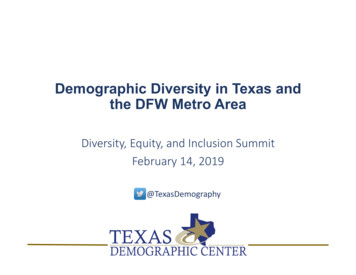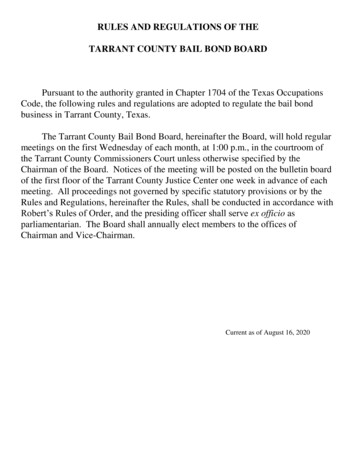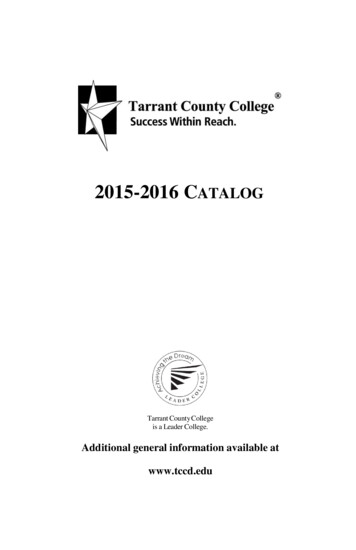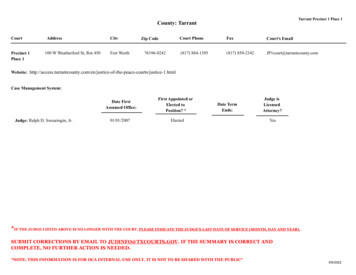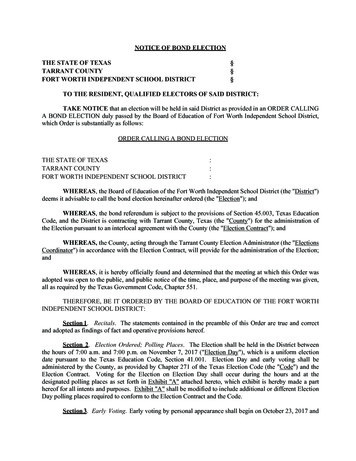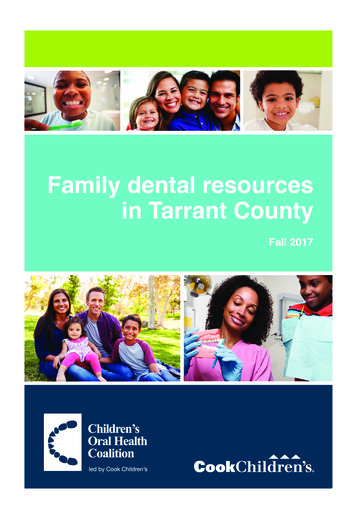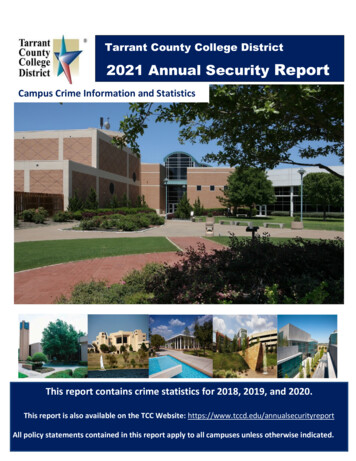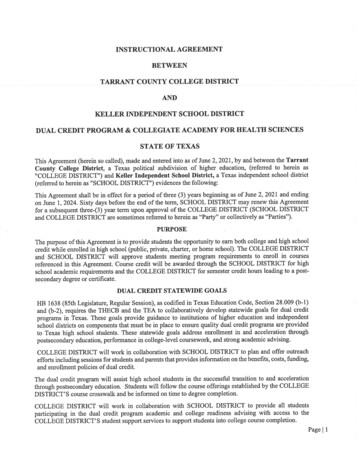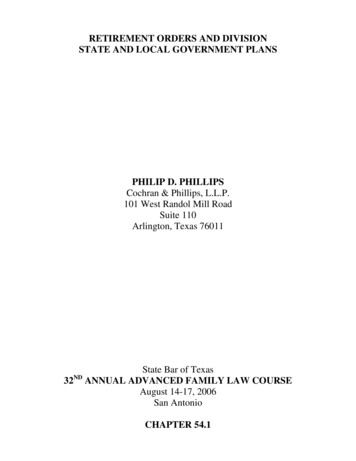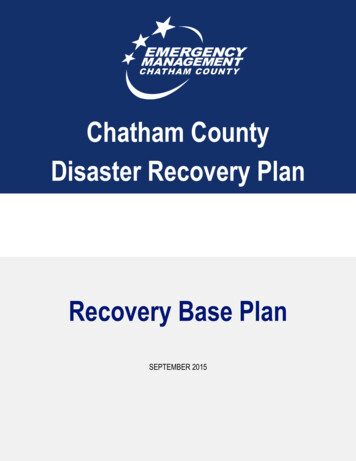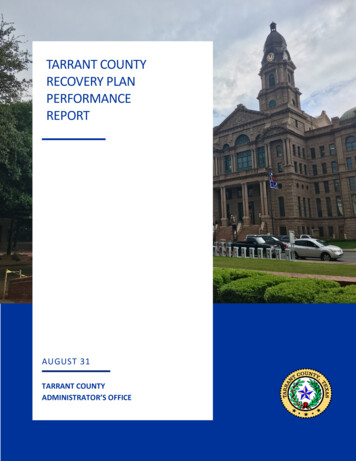
Transcription
TARRANT COUNTYRECOVERY PLANPERFORMANCEREPORTAUGUST 31TARRANT COUNTYADMINISTRATOR’S OFFICE
TARRANT COUNTY2021 RECOVERY PLANTable of ContentsGeneral Overview.2Executive Summary.2Uses of Funds .3Promoting Equitable Outcomes .5Community Engagement .5Labor Practices .6Use of Evidence .7Table of Expenses by Expenditure Category .7Project Inventory.8ARPA Programs Other Than SLFRF 9Emergency Rental Assistance Program .9Tarrant County Public Health Grant Funding .9Tarrant County’s 2021 Recovery Plan Performance Report1
GENERAL OVERVIEWExecutive SummaryGreetings,The Tarrant County Commissioners Court and County staff are committed to transparency andaccountability in reporting on programs and projects funded with dollars received through theAmerican Rescue Plan Act. Furthermore, we are committed to ensuring the voice of ourcommunity guides the decisions made regarding this historic investment of federal funding intoTarrant County.The American Rescue Plan Act (ARPA), through the State and Local Fiscal Recovery Fund(SLFRF), has provided local governments with the necessary resources to respond to thenegative effects of the COVID-19 pandemic and ensure a strong and equitable economicrecovery. Tarrant County is excited to partner with community members to ensure that thesefunds have the maximum impact for our residents, businesses, and local agencies.The Tarrant County Commissioners Court, the governing body of Tarrant County, is determinedto ensure the resources provided through the SLFRF are expended in the most effective,efficient, and equitable method possible. To that end, the Commissioners Court has engaged aconsultant to conduct a COVID-19 Needs and Resources Assessment, which is discussed atlength in the Community Engagement section of this report. The assessment, along with aseries of public work sessions, will ensure the Commissioners Court is equipped with acomprehensive understanding of the existing needs and resources within our community, andwill help guide their prioritization of projects funded by the SLFRF. While the first reportingperiod does not capture a wide range of expenses, we expect this report to become moresubstantive as our community engagement strategies inform the prioritization of funds andapproval of projects.Please make sure to sign up for the County Judge’s and your County Commissioner’snewsletter to stay up to date on opportunities to provide input on ARPA funding decisions, andnever hesitate to contact our office with any questions or concerns.Sincerely,G.K. MaeniusCounty AdministratorTarrant CountyTarrant County’s 2021 Recovery Plan Performance Report2
Uses of FundsFocus Areas, Goals, and Programmatic ActivitiesInformed by public feedback, and to establish a framework for utilization of the first tranche ofSLFRF dollars, the Tarrant County Commissioners Court has approved four (4) Focus Areaswith their respective goals and funding allocation. Along with the findings from a COVID-19Needs and Resources Assessment, these Focus Areas will guide the development, approval,and implementation of programmatic activities funded by SLFRF. The four (4) Focus Areas andtheir respective goals are detailed below.Focus Area 1: Prepare for the Future (First Tranche Allocation: 51,500,000)Through investments in our workforce, facilities, and programs, Tarrant County will position itselfto efficiently, effectively, and equitably serve the needs of our community. Goal 1: Expand & Improve Tarrant County Facilities for Optimal COVID-19 Prevention &MitigationGoal 2: Position the County’s Workforce to Respond to the Negative Effects of COVID19Goal 3: Ensure Equitable Access to Essential Government ServicesFocus Area 2: Improve Public Health & Wellness (First Tranche Allocation: 72,694,445)Through investments in our public health infrastructure, Tarrant County will transform its publichealth system to equitably address the health needs of the community and ensure pandemicpreparedness. Goal 1: Create a World-Class Public Health DepartmentGoal 2: Improve Access to Care in the Unincorporated AreaGoal 3: Address Disparities in Public Health OutcomesGoal 4: Improve Access to Quality Behavioral HealthcareFocus Area 3: Revitalize the Economy (First Tranche Allocation: 40,000,000)Tarrant County will position the local economy for a strong and equitable recovery by investingin the training, development, and support of our current and future workforce; supportingdisproportionately impacted industries; and identifying innovative opportunities for growth. Goal 1: Support Disproportionately Impacted IndustriesGoal 2: Strengthen Tarrant County BusinessesGoal 3: Improve Access to High Quality Dependent CareGoal 4: Expand Job Training & Workforce Development OpportunitiesGoal 5: Facilitate Economic Recovery Through InnovationFocus Area 4: Strengthen the Community (First Tranche Allocation: 40,000,000)Through investments in our community, Tarrant County will ensure residents are equipped withthe necessary resources to recover from the negative socioeconomic impacts of the pandemic. Goal 1: Respond to Individuals Experiencing Housing InsecurityGoal 2: Address Infrastructure NeedsTarrant County’s 2021 Recovery Plan Performance Report3
Goal 3: Support Community Recovery ProgramsGoal 4: Expand Community Violence InterventionsNote: An additional tranche of funding in the amount of 204,194,446 is expected to bereceived by Tarrant County in Spring 2022. The Commissioners Court will allocate these fundsat a future date.Expenditure CategoriesExpenditure Categories are provided by the United States Department of Treasury to streamlinethe reporting of the use of SLFRF funding. In the section below, you will find narrativedescriptions on the uses of funds within their respective expenditure category for the firstreporting period which covers May 10, 2021 to July 31, 2021.Expenditure Category 1: Public HealthThe Tarrant County Commissioners Court has not authorized any program under ExpenditureCategory 1; however, the Court does plan on exploring potential projects and expending fundsunder this category in conjunction with the results of the COVID-19 Needs and ResourcesAssessment and staff recommendations.Expenditure Category 2: Negative Economic ImpactsThe Tarrant County Commissioners Court has not authorized any program under ExpenditureCategory 2; however, the Court does plan on exploring potential projects and expending fundsunder this category in conjunction with the results of the COVID-19 Needs and ResourcesAssessment and staff recommendations.Expenditure Category 3: Services to Disproportionately Impacted CommunitiesThe Tarrant County Commissioners Court has not authorized any program under ExpenditureCategory 3; however, the Court does plan on exploring potential projects and expending fundsunder this Expenditure Category in conjunction with the results of the COVID-19 Needs andResources Assessment and staff recommendations.Expenditure Category 4: Premium PayThe Tarrant County Commissioners Court has not authorized any program under ExpenditureCategory 4 and does not currently plan to expend funds under this category.Expenditure Category 5: Water, Sewer, and Broadband InfrastructureThe Tarrant County Commissioners Court has not authorized any program under ExpenditureCategory 5; however, the Court does plan on exploring potential projects and expending fundsunder this category in conjunction with the results of the COVID-19 Needs and ResourcesAssessment and staff recommendations.Expenditure Category 6 – Revenue ReplacementBased on current guidance and preliminary calculations, Tarrant County did not identify a loss ofrevenue and, therefore, will not be expending funds under Expenditure Category 6. County staffTarrant County’s 2021 Recovery Plan Performance Report4
will recalculate revenue loss at the dates provided in the guidance issued by the United StatesDepartment of Treasury.Expenditure Category 7 – Administrative and OtherAll expenses captured within the first reporting period fall within Expenditure Category 7.Specifically, the expenses are categorized under Expenditure Category 7.1 AdministrativeExpenses. The expenses within this category consist of the salary and fringe benefitsassociated with one (1) Grant Manager employee. This employee is dedicated to oversight andaudit-related activities to ensure compliance with grant administration and reportingrequirements as prescribed by statute and Treasury-issued guidance.Promoting Equitable OutcomesPromoting equitable outcomes is a priority of the Tarrant County Commissioners Court andCounty staff, and all programs approved by the Commissioners Court will be designed withequity as a primary concern.For the first reporting period, the Commissioners Court has not approved any projects outside ofthe one (1) staff member focused on ensuring compliance with grant administration andreporting requirements. However, in future reports as projects are approved, the PromotingEquitable Outcomes section will include substantive documentation and narrative description ofprogrammatic goals, strategies, and outcomes as they relate to promoting equity in TarrantCounty. Program Evaluation Specialists will be tasked with developing performancemeasurement structures that capture quantitative and qualitative data, which will help illustratethe relationship between the county’s intended equitable outcomes and actual results.Furthermore, the county is focused on utilizing Qualified Census Tracts (QCTs) to targetprograms and resources to traditionally underserved and underrepresented communities.The COVID-19 Needs and Resources Assessment, discussed in further detail in the followingsection, will measure the negative economic impact of the pandemic on underrepresentedpopulations. Preliminary findings from the consultant conducting the assessment show thatMinority and Women-Owned Business Enterprises (MWBEs) were disproportionately impactedby the pandemic and closed at nearly twice the rate of other businesses. Findings from theCOVID-19 Needs and Resources Assessment will equip the Tarrant County CommissionersCourt with an accurate depiction of the impact of the pandemic on these communities and howSLFRF funding can be deployed to advance an equitable recovery.Community EngagementCommissioners Court Work SessionsCounty staff facilitated a series of public work sessions during regular meetings of theCommissioners Court. These ongoing work sessions provide relevant information related toeligible uses of SLFRF funding and information from subject matter experts and key communitystakeholders. In Work Session 3, for instance, subject matter experts from local mental healthorganizations and health providers presented an overview of pandemic-related impacts onvarious community health needs and associated strategies to respond to those impacts. Forexample, Dr. Jasmine Tiro, from UT Southwestern Medical Center, presented variousTarrant County’s 2021 Recovery Plan Performance Report5
community engagement strategies to eliminate health disparities within Tarrant County.Additionally, Virginia Hoft, Executive Director of Mental Health Connection, presentedcommunity-focused strategies to address mental health needs exacerbated by the COVID-19pandemic. These presentations have assisted in identifying pandemic-related community needsand potential programmatic strategies that can be supported with SLFRF funding.COVID-19 Needs and Resources AssessmentAlthough the expenses are not captured in the reporting period for the first report, the TarrantCounty Commissioners Court approved a contract with the management consulting firmInnovative Emergency Management (IEM) on Tuesday, August 3, 2021 to conduct a COVID-19Needs and Resources Assessment within Tarrant County. The COVID-19 Needs andResources Assessment will play a pivotal role in informing the allocation of relief funds and willensure that SLFRF funding is deployed in a manner which effectively, efficiently, and equitablymeets the needs of residents in Tarrant County.The COVID-19 Needs and Resources Assessment will consist of a GIS analysis to gaugeTarrant County’s Social Vulnerability Index; a pre-March 2020 profile of the county to gauge theimpact of COVID-19; and, most importantly, input and feedback from a wide variety ofcommunity stakeholders and the general public.Community engagement is the foremost priority of the COVID-19 Needs Assessment, and IEMwill employ several strategies to engage a diverse group of community leaders andstakeholders. Strategies to be employed during the needs assessment include, but are notlimited to, sector-specific surveys, zoom workshops with county leaders, and virtual roundtableswith community stakeholders. Community and faith organizations, nonprofit organizations,private sector organizations, and community leaders will be among those engaged throughoutthis process. Additionally, the public will have multiple opportunities to provide input in theassessment aside from the public comment section during Commissioners Court meetings.Needs Assessment Deliverables to Guide Decision MakingIEM will deliver an Interim Report to the Commissioners Court in September 2021. The InterimReport will provide information related to the initial findings of the GIS analysis, a preliminaryneeds and resources assessment, and identification of immediate needs within the community.In January 2022, IEM is slated to present the Final Report and Final Strategy andRecommendations. The Final Report will provide the results from data analyses and the needsassessment; outline the public outreach approach employed and findings; and provide data forcompliance and reporting purposes. The Final Strategy and Recommendations will consist ofprogrammatic recommendations which align with identified community needs and statutoryeligible uses. Furthermore, the Final Strategy and Recommendations will create a framework tocapture positive and measurable outcomes.Ongoing Communication with Intergovernmental PartnersIn addition to the Commissioners Court Work Sessions and COVID-19 Needs and ResourcesAssessment, the county conducts regular calls to engage intergovernmental partners andfacilitate cooperation, coordination, and collaboration among local entities. These calls alsoserve as a channel for information-sharing by allowing local partners to disseminate importantannouncements and information related to the pandemic. Among the calls are Tarrant CountyTarrant County’s 2021 Recovery Plan Performance Report6
Judge Glen Whitley’s weekly COVID-19 update for our local legislative delegation and CountyAdministrator G.K. Maenius’ ARPA discussion with local city managers to coordinate and avoidduplication of efforts in the context of local projects funded by State and Local Fiscal RecoveryFunds.Labor Practices for Infrastructure ProjectsNo infrastructure projects have been approved at this point.Use of EvidenceProjects included within the current and future Recovery Plan Performance Reports will berigorously evaluated. Tarrant County is in the process of hiring three (3) Program EvaluationSpecialists to develop program evaluation models and employ them in the context of SLFRFfunded projects. The second iteration of this report is planned to include detailed informationregarding program evaluation design and preliminary findings.Utilizing the COVID-19 Needs and Resources Assessment, the Commissioners Court will beequipped with the information to make evidence-based decisions and funding allocations. TheCOVID-19 Needs and Resources Assessment will provide the county with a baseline to affectreal and meaningful change in the community through targeted SLFRF investments.Additionally, project development will include the use of logic models to create linkages betweengoals, inputs, outputs, and outcomes. Logic models will assist in the development of KeyPerformance Indicators (KPIs) for each SLFRF-funded project and ensure clarity in therelationship between programmatic resources and outcomes.Table of Expenses by Expenditure CategoryThe Table of Expenses by Expenditure Category will list the cumulative expenses within eachExpenditure Category. For the initial report, the only expense reflected is the salary and fringebenefits for one (1) public sector employee. As the COVID-19 Needs and ResourcesAssessment progresses, additional expenses will be incurred and reflected in future reports.Category12345677.1Expenditure Category: Public HealthExpenditure Category: Negative EconomicImpactsExpenditure Category: Services toDisproportionately Impacted CommunitiesExpenditure Category: Premium PayExpenditure Category: InfrastructureExpenditure Category: Revenue ReplacementAdministrative and OtherAdministrative ExpensesTarrant County’s 2021 Recovery Plan Performance ReportCumulativeexpenditures todate ( )Amount spentsince lastRecovery Plan 28,013 28,013 28,013 28,0137
PROJECT INVENTORYThe Project Inventory aims to provide the United States Department of Treasury and thegeneral public with an overview of the various SLFRF-funded projects undertaken by TarrantCounty. In the first reporting period (May 10, 2021 to July 31, 2021), the Project Inventory willnot be as expansive as in future reports. This is a function of the Tarrant County CommissionersCourt hosting work sessions to solicit community input and onboarding an external consultant toconduct a COVID-19 Needs and Resources Assessment prior to developing and approvingprojects. This process will help ensure that SLFRF funding is expended in a manner whicheffectively, efficiently, and equitably meets the needs of our residents.Administrative Capacity for Implementation and Oversight of Recovery ProgramsProject Identification Number: F1G2BFunding amount: 1,992,696Project Expenditure Category: 7.1 Administrative ExpensesFocus Area: Prepare for the FutureGoal: Position the County’s Workforce to Respond to the Effects of COVID-19Project overview This project aims to ensure Tarrant County has sufficient staffing levels to respond to thenegative effects of COVID-19 and the administrative burden associated with theresponse. As of the first reporting period, the only expenses reflected under this projectare the salary and fringe benefit expenses associated with one (1) Grant Manageremployee in the Auditor’s Office to ensure compliance with applicable grantadministration and reporting guidelines for SLFRF. In future reporting periods, as theCommissioners Court approves SLFRF-funded programs, county staff expect severaladditional positions to fall under this project. This includes the Performance EvaluationSpecialist positions approved on August 10, 2021. This project is authorized by§35.6(b)(10) of the Interim Final Rule and FAQ 10.2 promulgated by the United StatesDepartment of Treasury.Use of Evidence The goals of the project are to ensure effective, efficient, and equitable administration ofSLFRF funding through adequate staffing. This project will employ a program evaluationspecialist to determine the effectiveness and efficiency of the project. This project will be evaluated through a rigorous annual program evaluation consisting ofa quasi-experimental research design to build a base of evidence for the interventionstrategies utilized during this project. The program evaluation design is currently indevelopment.Tarrant County’s 2021 Recovery Plan Performance Report8
ARPA PROGRAMS OTHER THAN SLFRFIn addition to the funding provided through the SLFRF, Tarrant County and local governmentsaround the nation received federal funding for other programmatic activities related to theCOVID-19 response. Below you will find information related to non-SLFRF programs which arefunded through ARPA.Emergency Rental Assistance Program (ERAP)The Tarrant County Emergency Rental Assistance Program (ERAP) is designed toassist eligible households who are unable to pay rent and/or utilities due to the COVID19 pandemic as established by section 501 of Division N of the ConsolidatedAppropriations Act, 2021 (ERA 1) and Section 3201 of Subtitle B, Title III of theAmerican Rescue Plan Act, 2021 (ERA 2). Tarrant County received 24,281,300 fromthe CAA and 26,407,662 from ARPA to assist with emergency rental assistance needs.Assistance may be provided for unpaid, overdue rent (arrears) from April 1, 2020, andfor future rent. Using a combination of ERA 1 and ERA 2, total months of assistance isnot to exceed 15 months, or 18 months if necessary, for housing stability as defined byUS Treasury.Programmatic Data:APPLICATION STATUSTOTALApplications in Progress1,299Applications Under Review133Ineligible Applications (Area & Income)424Applications Approved466TOTAL APPLICATIONS2,322Tarrant County Public Health (TCPH) Grant FundingTCPH received several grants funded by ARPA from several pass-through agenciessuch as the CDC and DSHS. The table below details ARPA-funded public health grantsreceived by Tarrant County.GRANT NAMECOURT APPROVAL DATEAMOUNT RECEIVEDCDC COVID-19 Health Disparities GrantJune 8, 2021 27,241,785DSHS – COVID-19 Vaccination CapacityEnhancement ProgramApril 27, 2021 12,349,513August 17, 2021 1,500,000DSHS – CDC Public Health CrisisResponse Workforce GrantTOTAL ARPA PUBLIC HEALTH GRANT FUNDING RECEIVEDTarrant County’s 2021 Recovery Plan Performance Report 41,091,2989
Although the expenses are not captured in the reporting period for the first report, the Tarrant County Commissioners Court approved a contract with the management consulting firm Innovative Emergency Management (IEM) on Tuesday, August 3, 2021 to conduct a COVID-19 Needs and Resources Assessment within Tarrant County. The COVID-19 Needs and
